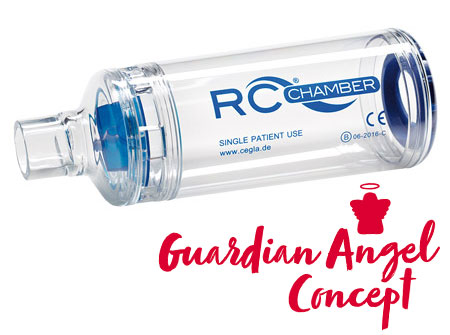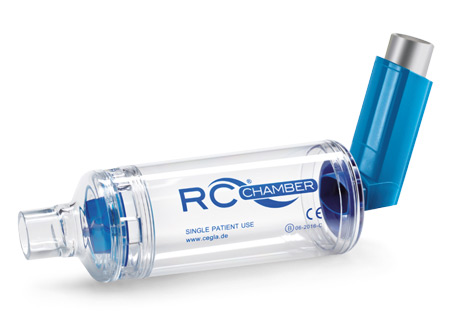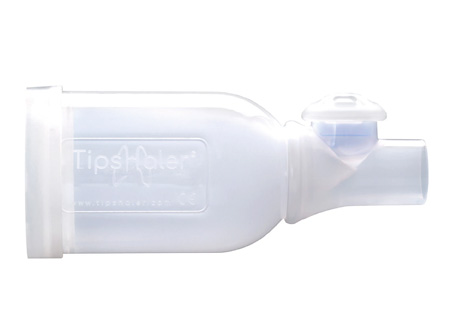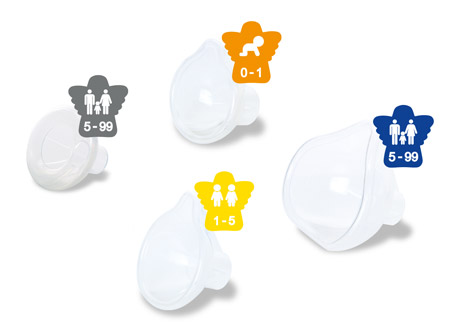Inhalation therapy
Inhalation therapy is a very important component in the treatment of the respiratory tract. By inhaling gaseous active ingredients, minute particles enter directly into the widely ramified system of smaller and larger airways.
RC-Chamber®

The RC-Chamber® spacer for inhalation with patented Guardian Angel concept optimises the effect of the medications during inhalation with metered-dose inhalers and is a reliable companion for both young and adult patients.
RC-Chamber® for tracheostomised patients

Allows tracheostomised and weaning patients to receive inhalation therapy with metered-dose inhalers. For cannulated patients as well as patients with an open tracheostoma.
TipsHaler-HospitHal®

Accessories

Interchangeable silicone masks are available in different sizes.
The products are available online as well as in pharmacies and medical supply stores.
Inhalation therapy – effect
With inhalation therapy, both the medication as well as the inhalation technique play an important role. In combination with the correct breathing technique, the following effects are achieved during inhalation therapy:
- The airways are moistened and thus their natural cleansing mechanism is supported.
- Secretions are loosened and diluted, and can be expectorated much more easily.
- Cramping of the bronchial musculature eases.
- The swelling and inflammation of the bronchial mucous membranes is alleviated.
- Inhalation therapy has an overall anti-inflammatory effect.
- Respiratory tract infection pathogens are combated.
Inhalations for asthma and COPD
Patients with asthma and COPD inhale medications with the help of special technical inhalation devices. Because the effectiveness of the medication fundamentally depends on how much active agent reaches the lungs, and how deeply it penetrates them, the choice of inhalation device is of critical importance.
Choosing the correct inhalation device depends in large part on the mental and manual abilities of the patient, and on the severity level of the disease. In cases of asthma and COPD, 3 types of inhalation devices are basically considered: gas-powered metered-dose inhalers, powder inhalers, and nebuliser systems.
Inhalation with metered-dose inhalers
In cases of asthma and COPD, most patients perform inhalations using metered-dose inhalers. They contain a mixture of gas and active agent particles that are released through a burst of spray. When inhaled, the active agent particles are then transported deeply into the airways.
Out of all inhalation devices, metered-dose inhalers do the best job at transporting the medication into the lungs. The effectiveness of the medication strongly depends, however, on the exact coordination between spray burst and inhalation. For this reason, the use of an inhalation device, also called a spacer or a chamber, is common. Spacers for inhalation simplify the coordinating action when inhaling with metered-dose inhalers, they increase the reach of the active agent and reduce the side effects of the medication.
Inhaling with spacers for inhalation
Spacers for inhalation magnify the effectiveness of the medication, facilitate the use of metered-dose inhalers, and offer smooth transportation of active agent into the airways.
In the process, they also act as active agent filters and as a link between the metered-dose inhaler and the oral cavity, through which the medication is breathed in. This is how the active agent particles arrive in your lungs, penetrating deeply into the airways.
Studies have demonstrated the effectiveness of spacers for inhalation in multiple regards.
The use of spacers for inhalation during inhalation therapy with metered-dose inhalers is thus recommended by experts and professional associations in equal measure.
The best drug deposition is achieved through inhalation device mouthpieces. However, many patients such as infants or small children, or even neurological patients, cannot control the inhalation properly. In such cases, doctors recommend spacers for inhalation with masks.
